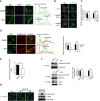Acid sphingomyelinase is required for cell surface presentation of Met receptor tyrosine kinase in cancer cells
- PMID: 27802163
- PMCID: PMC5117200
- DOI: 10.1242/jcs.191684
Acid sphingomyelinase is required for cell surface presentation of Met receptor tyrosine kinase in cancer cells
Abstract
Receptor tyrosine kinases (RTKs) are embedded in the lipid bilayer of the plasma membrane, but the specific roles of various lipids in cell signaling remain largely uncharacterized. We have previously found that acid sphingomyelinase (ASM; also known as SMPD1) regulates the conserved DAF-2 (the ortholog IGF-1R in mammals) RTK signaling pathway in Caenorhabditis elegans How ASM and its catalytic products, ceramides, control RTK signaling pathways remain unclear. Here, we report that ASM regulates the homeostasis of Met, an RTK that is frequently overexpressed in various cancers. Inactivation of ASM led to a rapid loss of Met from the plasma membrane, reduced Met phosphorylation and activation, and induced Met accumulation in the trans-Golgi network (TGN). However, trafficking of integrin β3 and vesicular stomatitis virus glycoprotein (VSVG) was largely unaffected. Knockdown of syntaxin 6 (STX6) also blocked the Golgi exit of Met. Depletion of either ASM or STX6 led to aberrant trafficking of Met to lysosomes, promoting its degradation. Our studies reveal that ASM and ceramides, together with STX6 and cholesterol, constitute a new regulatory mechanism for the exit of Met from the Golgi during its biosynthetic route, which is used to rapidly replenish and regulate the plasma membrane levels of Met in various cancer cells.
Keywords: ASM; Acid Sphingomyelinase; Ceramide; Golgi; Met; RTK; Receptor tyrosine kinase; SMPD1; STX6; Syntaxin 6.
© 2016. Published by The Company of Biologists Ltd.
Conflict of interest statement
The authors declare no competing or financial interests.
Figures








References
-
- Akasaki K., Michihara A., Fujiwara Y., Mibuka K. and Tsuji H. (1996). Biosynthetic transport of a major lysosome-associated membrane glycoprotein 2, lamp-2: a significant fraction of newly synthesized lamp-2 is delivered to lysosomes by way of early endosomes. J. Biochem. 120, 1088-1094. 10.1093/oxfordjournals.jbchem.a021526 - DOI - PubMed
Publication types
MeSH terms
Substances
Grants and funding
LinkOut - more resources
Full Text Sources
Other Literature Sources
Miscellaneous

